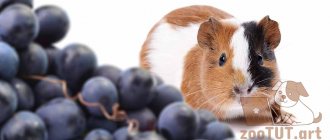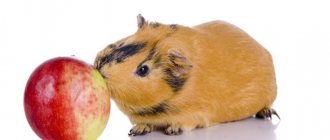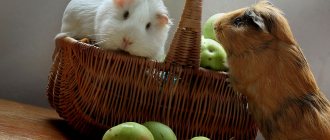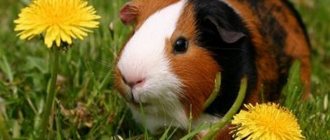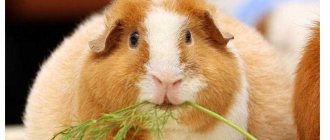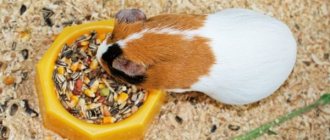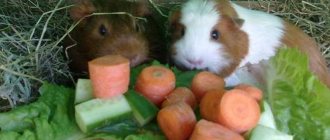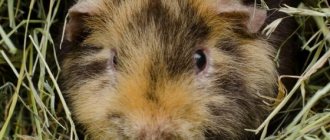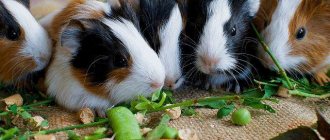Feeding a pet is a serious issue that every owner thinks about. After all, you want to feed your pet tasty and healthy food. The animal's diet is not limited to hay and grain feed.
Vitamins are important for animals for proper development and good health. Therefore, it is worth including them in the diet. Vegetables and fruits help saturate the body with essential microelements and vitamins ; they should be given to the rodent daily.
One of these supplements is banana. The guinea pig eats the offered treat with pleasure.
Do pets eat fruit?
Every owner of such a pet has noticed that the animal eats everything that is offered to it. And even if he eats a banana with pleasure, can he have this fruit? Since banana fruits are considered sources of potassium, the animal will receive considerable benefits from them .
But this does not mean that the rodent needs to be fed such a delicacy. After all, bananas also contain a lot of sugar, which negatively affects the condition of the guinea pig’s body. It is easy to conclude that such a product can be given to a pet, but in limited quantities .
Dairy
Can guinea pigs have milk?
Giving milk to guinea pigs is not recommended. The enzyme that is responsible for the breakdown of milk sugar (lactose) is found in insufficient quantities in the body of animals. If your pig drinks milk, the lactose will cause diarrhea and bloating. More serious diseases may develop in the future, so it is better to show your pet to a doctor.
Females can and even need to be given milk during lactation. You can soak crackers in milk and offer them to your pig.
The ban also applies to other dairy products: cottage cheese, cheese, yogurt and others.
What about banana peels?
Often, owners give a piece of this delicacy to their pets along with the peel. However, this should not be done . Of course, banana is a plant food, but suppliers treat the fruit with wax, ethylene and chemicals so that the product retains its presentable appearance longer.
And during cultivation, various nitrates and pesticides are used to increase the rate of growth and ripening. All these negative elements accumulate in large quantities in the peel . If they get into the animal’s stomach, then you will not be lucky enough to avoid disastrous consequences.
Therefore, it is important to remove the skin and soft tissues from the fruit before treating your pet with a healthy treat. It is also worth pre-processing an unpeeled banana: wash it thoroughly and scald it with boiling water.
Citrus fruits, pears, apples in the diet of guinea pigs
The basis of the daily menu for guinea pigs is cereals and fresh plant food. However, not all types of vegetables, fruits or berries are beneficial for these rodents.
Table 1. Forbidden foods
| Products | Herbs | Berries |
| Rhubarb, sorrel, chicken eggs, garlic, onions and green onions, sugar, milk, sweet cookies. | Leaves and stems of celandine, mint, fern, thyme, snowdrop, basil, foxglove, aloe, honeysuckle. | Plums, peaches, apricots, cherries. |
Interesting! Veterinarians advise adding spinach leaves, beet and radish tops, parsley, and dandelion leaves to the menu of pet rodents.
In order for animals to receive enough vitamins and microelements, they must eat at least 120 g of fresh fiber daily. Before giving vegetables or fruits to your pet, they must:
- Wash thoroughly.
- Cut into pieces (small so that the animal can eat them completely).
Important! Spoiled or rotting products should not be used to feed domestic rodents.
Citrus
The diet of guinea pigs includes 3 parts:
- basic (grain mixtures, most often made from oats);
- additional (treats);
- vitamin and mineral (supplements).
The body of furry pets does not know how to reproduce vitamin C on its own; it is “extracted” from food.
Zoological experts strongly advise against feeding guinea pigs citrus products regularly.
Important! Before giving fruit to animals, the fruits are freed from seeds and peel. The zest is strictly contraindicated for guinea pigs.
Some rodents are ready to treat themselves to juicy oranges or tangerines at least every day, but this should not be allowed. A healthy animal is allowed to eat a piece of orange, tangerine or grapefruit 1-2 times in 7-10 days.
Important! Citrus fruits should not be given to young pigs with an immature digestive system and to females during pregnancy or lactation.
Uncontrolled consumption of citrus fruits can cause serious health problems in animals. The most common of them are:
- hypervitaminosis;
- skin irritations;
- allergic rashes;
- change in the composition of urine.
If you decide to pamper your guinea pig with tangerine, you can give it only 1 slice. If there are several individuals in one cage, it is necessary to carefully monitor that the more nimble pets do not eat someone else’s food. 1–2 hours after the meal, the remaining food is removed.
Interesting! The animals should be observed after feeding citrus fruits. If digestive problems occur, the treat should be excluded from the diet.
Pears
The leaves and young branches of pear trees are very useful for the health of rodents. The fruits themselves can be given to animals only occasionally, as a treat.
If you offer your guinea pig a pear, you need to give it water at the same time. High levels of sucrose in juicy fruits often provoke the development of diarrhea in rodents. To neutralize the adverse effects, you should reduce the concentration of sugar in the body of your furry pets and dilute the treat with water.
For guinea pigs, it is better to choose firm varieties of pears. The average norm per day is approximately 40–45 g. These fruits can be fed to rodents along with the peel. However, it is better to remove the seeds in advance to avoid complications with the digestive system.
Apples
These fruits are simply necessary for guinea pigs to maintain health and daily activity. Most animals prefer sweet varieties. The most useful fruits for rodents are Antonovka, Titovka, and Semerenko.
Fruits have a perfectly balanced ratio of fructose (80%) and sucrose (18%). In addition, they contain pectin, fiber, B vitamins, and beneficial minerals.
Interesting! If the apples are dried, they are soaked and boiled before feeding.
Pigs enjoy eating both fresh and dried apples. The fruits are first peeled and cut into small slices. The maximum amount of treats at one time for each animal is no more than 3 pieces.
Important! Apple seeds must be removed in advance. They contain a substance that, when exposed to gastric juice, is converted into hydrocyanic acid, a high concentration of which can kill the animal.
Feeding rules
Do not forget that sweets have a bad effect not only on human health, but also on all living beings. It is extremely important to take this into account when feeding your guinea pig such treats. Since the fruit is a storehouse of nutrients and vitamins, but also sweet, it should be given strictly in accordance with the dosage. This will help not harm your pet's health.
to babies who have not yet reached three months of age .
And only after this age limit can bananas be introduced into the rodent’s diet. It is advisable to start complementary feeding with a small piece once a day. 1/6 of the fruit is enough.
After the first dose, it is important to monitor the guinea pig’s reaction. If no changes occur within 24 hours, then the fruit can be given regularly, gradually increasing the dosage. Adults are treated daily to an amount of treat that does not exceed ¼ the size of the fetus .
Banana is also useful for guinea pigs that have reached “retirement” age. It will not only saturate the animal’s body with the missing elements, but will also allow it to spend less energy on eating food. The animal no longer has the strength it used to have, and it is difficult for it to chew hard grain. Therefore, he will like a soft banana.
How to give correctly
Moderation is good in everything. In general, feeding a guinea pig, as a rule, involves 2-3 meals a day, where breakfast is “juicy food,” greens and hay. It is for breakfast that the bulk (but not the entire daily requirement!) of vegetables and fruits is served. You should be careful when introducing fruit into your diet, not only when it comes to exotic bananas, tangerines, and so on. Apples and pears, so accessible and understandable in our latitudes, are the most common cause of stomach upset in rodents. Most often, it is precisely because of the carelessness of the owners, who are focused on their own perception of these food products.
Possible problems
Animals, like people, can suffer from overeating. The stomach is not always able to process excess amounts of food, which negatively affects the pet’s condition. And excessive consumption of sweets does not have the best effect on health.
Should I give my pets kiwi?
Do not forget that the product given to the rodent must be of high quality . This will protect your pet from poisoning and diarrhea. In addition, banana is considered an astringent product.
An excessive amount of such treats will not allow the animal to go to the toilet in a timely manner. And irregular bowel movements and retained excrement in the body have a negative impact.
Overeating and low-quality products cause harm to the animal. It is important to remember that it is important to approach your pet’s nutrition as responsibly as you do your own.
Is it possible to eat the peel?
It must be remembered that you are allowed to give your guinea pig banana only in its peeled form. These rodents readily eat banana peels, but this can cause great harm to their health. To extend shelf life and protect against insects, the surface of the fruit is always coated with wax, ethylene, and various chemicals. Therefore, before peeling the fruit, it is recommended to first wash it with soap. The fruit shell is also the site where all the pesticides and chemicals used during cultivation accumulate. Therefore, if a rodent eats even thoroughly washed peels, it can become seriously poisoned.
Read about which exotic fruits are healthy and which are harmful for guinea pigs in the article “Can guinea pigs be given pineapple, kiwi, mango and avocado?”
What other fruits and berries can you give?
Guinea pigs love fruits; there are no clear recommendations or contraindications. When choosing, you should consider two points:
- Vitamin C is essential for guinea pigs because their body does not produce it. Without its consumption, the animal can be completely paralyzed.
- Some foods are allergenic (citrus fruits), which is why you should first try giving a small dose and only if your pet reacts positively to it, continue feeding it.
Otherwise, these animals are very omnivorous, especially in matters of fruits and berries.
You can and even need to please your pet with bananas. And if you approach the issue responsibly and sensibly, then feeding will bring a lot of pleasure to the pig. And as you know, a happy pet makes its owners happy too.
Bottle with drinker
Such an accessory will come in handy during street walks. It does not take up much space, weighs little and does not hinder movement. But you can offer the dog to quench his thirst at any time, and not wait until he starts drinking from a dirty puddle or lake overgrown with mud.
The device consists of a water container and a bowl equipped with a dispenser button. It allows you to release as much liquid from the bottle as the animal needs to quench its thirst. Sold in two volume options - 350 and 550 milliliters.
Price – 475 – 584 rub.
Another model of the same device has a folding shape, which makes it easier to carry. The transformer connects the bowl and the bottle, securely fixing them in such a compact state. The durable polymer material has good shockproof properties and can even resist dog teeth. True, this struggle will not be long and - if the owner is careless - then all the liquid will end up on the ground.
Volume 250 ml.
Cost – 133 – 148 rubles.
I like1I don't like
Why can't you give too much?
Sweets have a bad effect on them and can harm their health. Therefore this needs to be taken into account. The fruit contains many vitamins and nutrients, and it is sweet and therefore the dosage is very important so as not to cause harm. It is better to wait until the animal is 3 months old and then give it a piece. But you should start small, about 1/6 of a banana will be enough. Check the reaction, if everything is fine within 24 hours, then give more next time. But it is not advisable for one serving to be more than 1/4.
Article on the topic: What to feed a guinea pig at home: food and a list of foods that can and cannot be included in the diet
In terms of benefits, many products carry a higher priority. For example, ascorbic acid is vital, so it must be given. It is found in rowan and green grass. In the wild, the pet looked for food for itself and knew what it needed. Fresh grass cleverly replenished the supply of vitamins in the body. At home, everything depends on you. Do guinea pigs eat bananas? Of course they eat, they are constantly chewing something when you are not looking at them. But this does not mean that you should give it all the time. Include this product in your diet in small quantities.
It is even recommended to give aging pigs a banana, as well as boiled potatoes, pumpkin and cucumbers. This is due not only to vitamins, but also to physical condition. The animal no longer has the strength it used to have, and often it is difficult for it to chew grain, and sometimes it is not able to do it at all.
